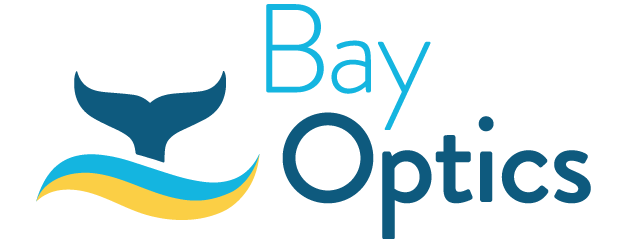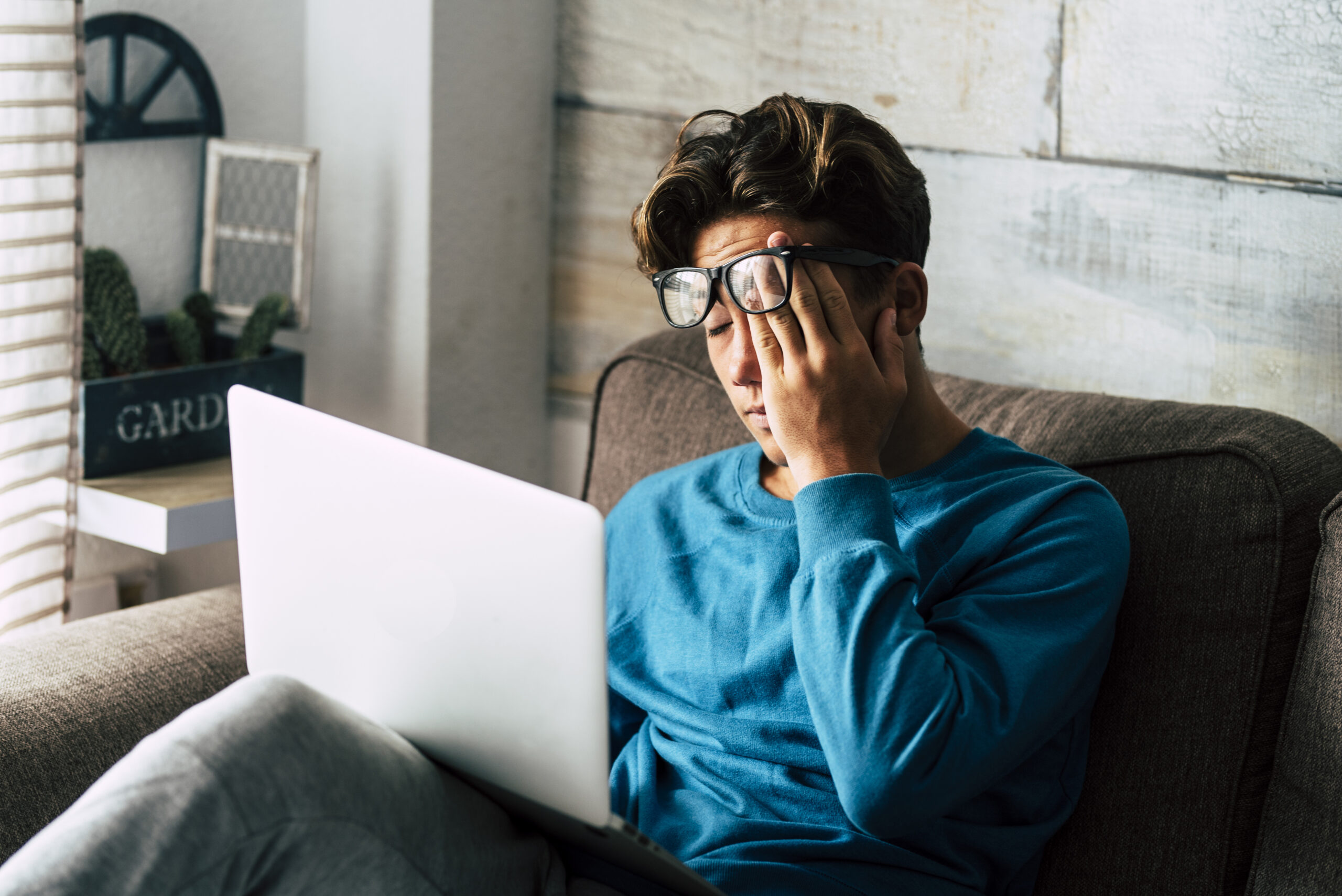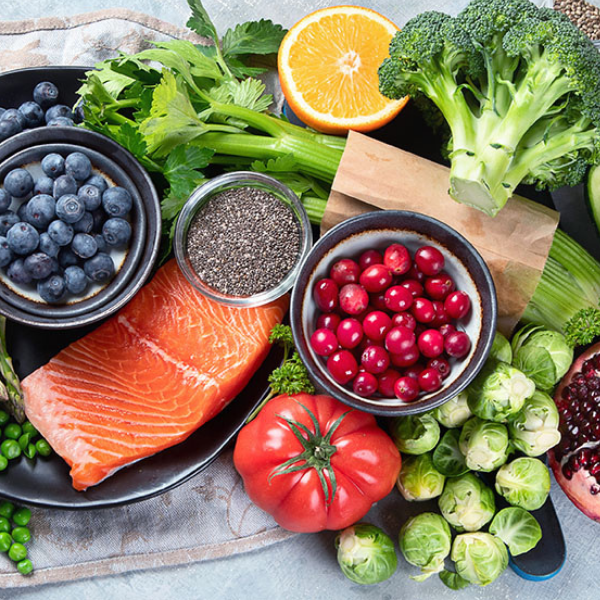Are your eyes feeling tired?
Looking at digital screens all day is a reality for many of us in today's world. While the convenience of technology is undeniable, the constant eye strain it can cause takes a toll. Here's where vocational lenses step in, offering a solution to combat screen fatigue and improve your work experience.
Vocational lenses aren't your average everyday glasses. They are specifically designed for optimal vision, personalised to your working distance and digital screen needs. This means clear vision, whether you're staring at your computer screen, reading reports, or collaborating across the table.
Traditional lenses might not be equipped to handle the constant near-focusing required for digital tasks. This can lead to eye strain, headaches, and blurred vision. Vocational lenses help alleviate these issues by providing a gentle focusing "boost" within the lens, allowing your eyes to relax and adjust more comfortably throughout the day.
Beyond improved vision, vocational lenses can also promote better posture. By optimising your visual comfort, you're less likely to slouch over your desk or crane your neck to see clearly. This can lead to improved body alignment and reduce body aches, contributing to an overall sense of well-being at work.
If you spend a significant amount of time working on digital screens, vocational lenses are an investment worth considering. They can offer a solution to:
- Reduce eye strain and fatigue
- Improve visual comfort at your working distance
- Promote better posture and reduce body aches
- Enhance your overall work experience
Book an appointment and talk to our team
See More, Do More: Explore the Possibilities of Smart Lenses
As we age, our bodies subtly change, and our vision is no stranger to this evolution. One common age-related shift is presbyopia, where focusing on close up objects like reading material or phone screens becomes increasingly challenging. While multifocal glasses have been the traditional remedy, smart lenses are emerging as a technologically advanced alternative.
Presbyopia: A Natural Progression
Presbyopia isn't a disease, but a natural consequence of age. Around the age of 45, the lenses in our eyes lose flexibility, making it harder to focus on near objects. This often leads to eye strain, headaches, and the frustration of reaching for the reading glasses we might have forgotten.
Smart lenses go beyond basic correction; they are technologically infused solutions designed to combat the difficulties of presbyopia. They seamlessly adapt to different distances, offering clear vision for both near and far objects. Here's what sets them apart:
- Multiple Zones: Unlike the visible lines of traditional multifocal lenses, some smart lenses have built-in zones within the lens, allowing your eyes to focus effortlessly on various distances.
- Light-Adjusting Power: Certain digital lenses take things a step further by automatically adjusting their focus based on the surrounding light, ensuring optimal vision in all lighting conditions.
- Personalised Touch: Advanced smart lenses can even be customised to your specific vision needs, offering a truly personalized experience.
Benefits of Smart Lenses:
- Clear and comfortable vision at all distances.
- Reduced eye strain and fatigue.
- Elimination of the need for multiple pairs of glasses.
- Improved quality of life for everyday activities.
Talk to our Team today to find out more.
7 ways to maximise your health fund benefit
Healthcare is a fundamental aspect of our lives, and it's essential to make the most of your health fund benefit. By doing so, you can ensure that you and your family receive the best care without breaking the bank. Here are seven tips to maximise your health fund benefit:
- Understand Your Policy:
The first step to getting the most out of your health fund is to thoroughly understand your policy. Different policies cover various services, so take the time to familiarise yourself with your specific coverage. This knowledge will help you make informed decisions regarding your healthcare needs.
- Waiting Periods:
Be aware of waiting periods for specific services. Most health funds have waiting periods for major treatments, so plan accordingly.
- Regular Check-Ups:
Preventive healthcare is a cornerstone of maintaining good health. Schedule regular check-ups and screenings, even if you feel well. Early detection of health issues can save you money in the long run by preventing the need for costly treatments.
- Consider Extras Coverage:
Extras coverage, often offered as an add-on to your basic policy, can cover services like dental, optical, and physiotherapy. It's worth exploring whether adding extras coverage is a cost-effective option for your specific healthcare needs.
- Opt for Gap Cover Insurance:
Gap cover insurance can help reduce or eliminate the out-of-pocket expenses associated with in-hospital treatments. It's a valuable addition to your health fund benefit that ensures you won't be burdened by unexpected costs during your hospital stay.
- Claim Smartly:
Keep track of your eligible expenses and ensure you claim for every eligible service. It's important to understand the waiting periods, annual limits, and any sub-limits that might apply to certain services to avoid any surprises when claiming.
- Review and Update Your Policy:
Your healthcare needs may change over time, and so should your health fund policy. Regularly review your coverage to ensure it aligns with your current requirements. This will prevent you from paying for services you don't need while potentially saving on those you do.
By following these seven strategies, you can make the most of your health fund benefit, ensuring that you and your family receive quality healthcare while keeping your financial well-being in check. Stay informed, be proactive about your health, and make the most of your health fund for a healthier, happier life.
Why you should wear sunglasses
Australia has some of the highest levels of ultraviolet (UV) radiation in the world, especially during the summer months. UV radiation can damage your eyes and lead to serious eye problems, including cataracts, macular degeneration, and pterygium.
Wearing sunglasses is one of the best ways to protect your eyes from UV radiation. Sunglasses should block at least 95% of UVA and UVB rays. They should also fit snugly to prevent light from leaking in around the sides.
Here are some of the benefits of wearing sunglasses in Australia during summer:
- Protect your eyes from UV radiation: UV radiation can damage the cornea, lens, and retina of your eyes. Wearing sunglasses can help reduce your risk of developing cataracts, macular degeneration, and pterygium.
- Reduce glare: Glare can make it difficult to see and can increase the risk of accidents. Sunglasses can help reduce glare and make it easier to see in bright conditions.
- Improve your comfort: Sunglasses can help protect your eyes from the wind and dust. They can also help reduce eye strain.
- Shielding Delicate Skin Around the Eyes: the sensitive skin around your eyes is prone to damage from sun exposure. Wearing sunglasses not only protects your eyes but also prevents premature aging and skin issues caused by UV exposure. It's like a double benefit for your face!
If you wear eyeglasses, you can get sunglasses with prescription lenses.
To find the perfect pair of sunglasses for your needs, visit our practice. We have a wide selection of sunglasses from leading brands, and our experienced team members can help you choose the right pair for your face shape and lifestyle.
Performance and Eye Protection
In the world of sports and physical activities, having the right equipment is essential for optimal performance and safety. However, one critical component that often gets overlooked is sports eyewear.
Performance Enhancement
- Visual Clarity: Sports-specific eyewear, such as polarized sunglasses, improves visual clarity by reducing glare and enhancing contrast, enabling athletes to excel even in challenging conditions.
- Eye Protection: Sports eyewear acts as a shield, protecting your eyes from dust, debris, and harmful UV rays, allowing you to focus on your performance without worries of eye damage.
Safety First
- Preventing Eye Injuries: Sports eyewear acts as a protective barrier, safeguarding your eyes from flying objects or accidental contact with others, reducing the risk of eye injuries.
- UV Protection: Proper UV-protective sports eyewear shields your eyes from harmful rays, minimizing the risk of conditions like cataracts and macular degeneration.
- Dust and Debris: Outdoor sports expose your eyes to wind, dust, and debris, leading to irritation. Sports goggles or sunglasses with proper seals reduce this risk and prevent potential infections.
Sports eyewear is a crucial part of your sports gear, enhancing performance while keeping your eyes safe. Whether you're a professional athlete or enjoy recreational sports, investing in appropriate sports-specific eyewear ensures a better experience. Prioritize eye safety and visual clarity, and perform at your best with confidence. Remember, your eyes deserve the best protection!
Eye Strain and Screens: A Modern Dilemma
In today's fast-paced world, screens have become an integral part of our lives. Whether for work, education, or entertainment, we find ourselves constantly connected to smartphones, computers, tablets, and televisions. However, this digital revolution has brought an unexpected cost: eye strain.
Factors Contributing to Eye Strain
- Blue Light: Screens emit blue light that can disrupt our sleep-wake cycle, causing digital eye strain.
- Screen Glare: Reflections and glares force our eyes to work harder, leading to fatigue.
- Digital Device Usage: Prolonged use without breaks strains our eyes.
- Poor Lighting and Viewing Distance: Inadequate lighting and improper viewing distance contribute to eye strain.
Tips to Reduce Eye Strain
- Follow the 20-20-20 Rule: Take a 20-second break every 20 minutes to focus on an object 20 feet away.
- Proper Lighting: Ensure adequate lighting to avoid screen glare.
- Adjust Screen Settings: Reduce brightness and adjust contrast for comfort.
- Use Blue Light Filters: Consider using blue light filter apps or glasses.
- Maintain the Right Distance: Position screens at arm's length and eye level.
Prevention is key to avoiding long-term problems. Balancing screen time with breaks and outdoor activities can significantly improve eye health in this digital age. Prioritize eye care for a healthier and more enjoyable digital experience.
Back to School Eye Exams
The back to school season brings a flurry of emotions for parents of school aged children. We all know that kids grow quickly, which often means its time a new uniform as well as stationery, books and a long list of other back to school equipment. But there’s one area in particular that often gets neglected – their eyes.
As school recommences in 2022, it is important to get your child’s eyes examined. Approximately 20% of children in Australia suffer from a vision problem and worse yet, children often think that what they see is normal so they are unlikely to flag any issues with teachers or parents.
Vision problems can significantly affect learning with a recent Australian study of Year 3 children finding that those who were screened and identified as requiring glasses scored considerably lower in their NAPLAN relative to their peers.
Children of any age can have their eyes examined but it’s highly recommended that children starting kindergarten see their local optometrist to ensure they are getting the very best start to their schooling life.
Common signs of possible vision problems to look out for include:
- Frequent squinting
- Eye rubbing
- Eye turn
- Holding reading materials very close to their eyes
It’s equally important for parents to bring their children in for regular follow up eye examinations if they are already in glasses so that we can identify any changes to their script and make adjustments accordingly.
You can book an appointment with our practice today to ensure your child’s eye health.
10 Foods to Assist Your Vision
Eating the right foods can protect your vision and keep you healthy. Adding vitamins, antioxidants and minerals to your diet can improve your overall eye health. Researchers have linked eye-friendly nutrients, such as lutein and zeaxanthin, vitamin C, vitamin E and zinc, to reducing the risk of certain eye diseases like age-related macular degeneration and cataracts.1 You can find these antioxidants in green leafy vegetables, fruits, nuts and a lot of other foods.
Here are the top 10 foods that will boost your eye health.1, 2
Carrots
The hype is true, carrots are good for your eyes. These crunchy root vegetables are a great source of vitamin A, which is important for keeping your cornea clear. Carrots get their bright orange colour from beta carotene, which is essential for vitamin A production in the body. Other foods rich in beta carotene include sweet potatoes, pumpkin, capsicum, mangoes, apricots and rockmelon (and any other bright yellow or orange fruits and veggies you can get your hands on).
Fish
Fish is a very good source of omega-3, which is an important nutrient for eye health. Omega-3 is a polyunsaturated fatty acid which are essential for your body to produce new cells, muscles, nerves and organs, as well as having potent anti-inflammatory properties. They benefit our eye by nourishing the retina and aid tear production to keep the eyes moist and healthy, reducing dry eye syndrome.
Leafy green vegetables
Easy to digest, easy to include into every meal, and readily available, leafy greens are great not just for your eyes, but for your overall health. The darker the green, the better they are for you. Leafy greens such as kale, spinach and green veggies are packed with lutein and zeaxanthin, which are important for keeping your retina healthy. Broccoli, avocados and peas are also good sources of this powerful combination of antioxidants.
Berries and Citrus fruits
Oranges, lemons, red capsicum and berries are high in Vitamin C – a water soluble vitamin and a powerful antioxidant that helps the body form and maintain connective tissue, including collagen found in the cornea of the eye. Vitamin C also promotes healthy bones, skin and blood vessels, including the delicate capillaries in the retina.
Legumes and Pulses
Legumes are plants, pods and seeds that belong to the Fabaceae family. They refer to foods like peas and beans, such as green beans and broad beans. Pulses are dried legumes. They include chickpeas, black-eyed peas, kidney beans, mung beans, and lentils. Not only are legumes and pulses a protein powerhouse and an excellent source of fibre, they are also full of omega-3.
Nuts
Pistachios, almonds, walnuts, whichever take your fancy, are excellent sources of Vitamin E and minerals such as zinc that help keep your eyes healthy and may decrease your risk of age-related macular degeneration.
Seeds
Like nuts and legumes, seeds are high in omega-3s and are a rich source of vitamin E to help fight age-related eye health issues. Seeds such as chia seeds, pepitas, flaxseed, hemp seeds and sunflower seeds will help protect your retina.
Extra-virgin olive oil
The queen of oils, extra virgin olive oil can help your body absorb lutein and zeaxanthin, those all-important carotenoids that are vital for good eye health.
Eggs
Two of the most powerful antioxidants for eye protection, lutein and zeaxanthin, are found generously in egg yolks, just like in leafy green vegetables. When you have them in your omelette, you’re increasing your chances of antioxidant absorption because of the high-fat content of eggs. You also get ample vitamin C and E in the egg yolk, which are believed to be helpful against macular degeneration.
Lean Meat
Protein from lean meats such as beef, poultry (chicken, duck, turkey etc) or pork can be beneficial to your eyesight. Beef is rich in vitamin A and zinc, both of which are beneficial to your cornea and your retina. Poultry and pork are also good sources of zinc.
As well as adding these 10 superfoods to your diet, you should also consider piling your plate with plenty of other fresh fruits and vegetables. Aim to get your two serves of fruit and five serves of vegetables daily. The more colourful your cuisine gets, the better it will be for your eye health. As an added bonus, your overall health will benefit too.
References
1. American Optometric Association , “Diet and Nutrition,” 2020. [Online]. Available: https://www.aoa.org/healthy-eyes/caring-for-your-eyes/diet-and-nutrition?sso=y.
2. L. Arundel, “Top foods that can improve your eye health,” Good Vision For Life, 2016. [Online]. Available: https://goodvisionforlife.com.au/2016/08/04/top-ten-foods-can-improve-eye-health/
Holiday Trading Hours
Holiday Trading Hours
Friday, December 24: 9am - 1pm
Our practice will be closed from Saturday, December 25 and will re-open Tuesday, January 4.
On behalf of everyone at Bay Optics, we wish you all a happy and safe holiday season.
Have you used your health fund benefits?

2022 is fast approaching, which means most health fund rebates will expire unless you make a claim.
To get into the end of the year spirit and to help with a fresh new look, we'd like to gift you $50* towards your next pair of spectacles or sunglasses.
This offer is valid from 1 November until 31 January 2022, so even if you've used your optical health fund benefits for this year, you can make a new claim from 1 January and take advantage of these great offers.
Book in your consultation now.
*Redeemable for new purchases from 1 November 2021 towards purchase of complete frames and lenses. To claim your 2021 rebate, orders must be collected by 31 December 2021. Not to be used in conjunction with any other discounts, packages or offers. Not redeemable on contact lenses. One voucher per patient only.










